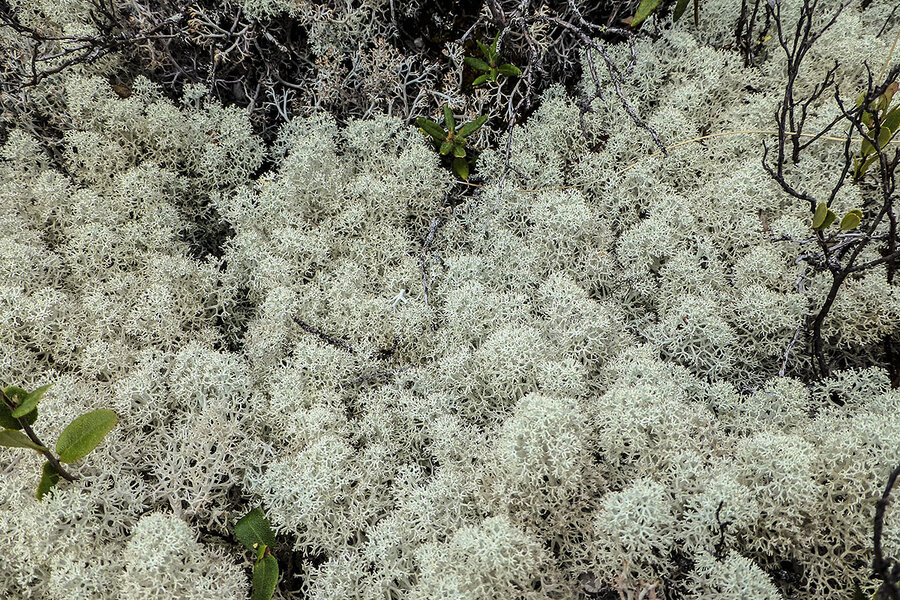Heads up, maple leaf. Canada’s eyeing another national icon.
Loading...
| Toronto
Some of the world’s great collaborators just might live in your backyard.
They are part fungus and part algae or cyanobacteria, living in symbiosis. And they can be found on every continent in the world. In Canada, many residents may recognize lichen from local parks or favorite hiking trails, but they’d be hard-pressed to name them – until now.
A group of enthusiasts is pushing forward with a plan to get Canada to adopt a “national lichen.” And more than 18,000 Canadians weighed in on a vote organized by the Canadian Museum of Nature in Ottawa. The star-tipped reindeer lichen, which resembles a mat of soft tufted cauliflower, emerged victorious, with 26.6% of the vote. Now the results will be handed to the Department of Canadian Heritage to consider.
Why We Wrote This
Sometimes it takes a crisis for people to embrace everyday wonders. In Canada, a national lichen contest has shone a new light on ecology at a time when many residents are finding a renewed embrace of nature.
This all may seem a frivolous venture during the coronavirus pandemic. But Toby Spribille, who studies lichen symbioses at the University of Alberta, says on the contrary it’s come at a time when people are reconnecting with nature. It’s also a time when people, confronting a universal vulnerability that calls for global cooperation to beat it, are rethinking complex systems.
“There’s something about lichens that forces people to think about working together,” he says. “because as soon as people realize that it’s a symbiosis ... it gets them thinking about organisms that work together with each other.”
What’s more, lichens exemplify a kind of natural stability that has endured for millions of years, he adds. “A lichen is basically a looking glass into another way of being.”
If adopted, Canada would become the first country in the world to recognize the composite organism (only California has gone so far, when it chose for the state the lace lichen in 2015).
Canada has among the highest lichen biomass in the world, competing only with Russia. They are most abundant in boreal forests and across the Arctic. It is the primary winter food source for one of Canada’s most beloved animals, the caribou, which graces the Canadian quarter, and provides nesting and camouflage for other species. It has been used by First Nations in dyes and medicine. Some fix atmospheric nitrogen for the soil and prevent erosion. They are also indicators of air pollution.
The project has aimed to generate “a greater awareness of this pretty important group that’s everywhere that nobody seems to know about,” says Troy McMullin, a research scientist and lichenologist with the Canadian Museum of Nature.
For many in Canada and around the world, nature has become one of the only escapes from full or near lockdown, as residents have been asked to stay at home to slow the spread of COVID-19. Many people are finding comfort in new connections to the natural world, either in their own backyards or area parks.
This reporter was prompted by the vote to take her daughter on a lichen hunt in Toronto’s High Park, where candle flame lichen became the subject of an impromptu science class.
The race, whose results were released today, stirred passion about lichens that took even the organizers, and some voters themselves, by surprise. Choosing among seven lichens (narrowed down from more than 2,500 species in Canada) with names like common freckle pelt, horsehair, elegant sunburst, and of course the winning star-tipped reindeer, there was no lack of interest or division.
On one Reddit thread before voting wrapped up, one user wrote: “This is something I had no idea would be important to me. Voted.”
Another: “I am glad for this opportunity to fulfill my national duty.”
One user gunning for the winner wrote it was obviously superior “to all other lichen. Anyone who says otherwise is a fool.” And a dissenting voice: “Common freckle pelt, or die.”
This all illustrates a certain fervor in the world of lichens, even if lichenologists insist they're not as fanatical as birders. In 2015, a similar vote in Canada turned divisive over the rival merits of the loon and the grey jay; in the end, no national bird was selected.
Still Dr. McMullin talks in tones that match lichens’ colorful names. “All throughout the boreal forest, they’re dripping from the trees,” he says. “I call them the corals of the forest with these bright, brilliant colors, amazing shapes and forms.”
Whether a national lichen could ever be as universally recognizable as the maple, the country’s national tree, remains to be seen. But Dr. McMullin puts heart into his defense. “Why is a tree more important than a lichen? Because it’s big?” he says. “We should appreciate the small things in life, because they’re all part of an ecological system that we are part of.”









